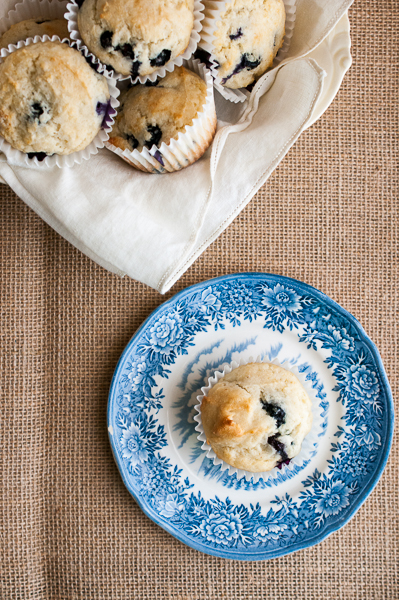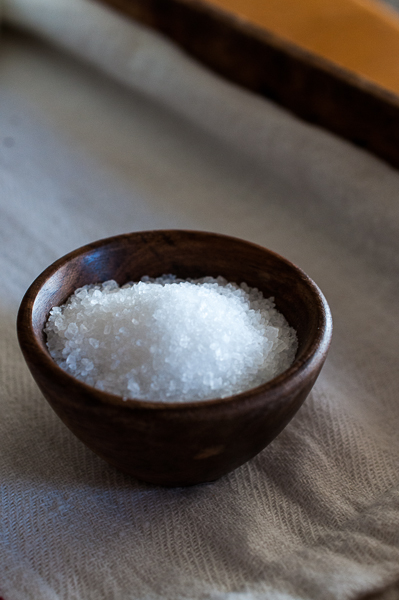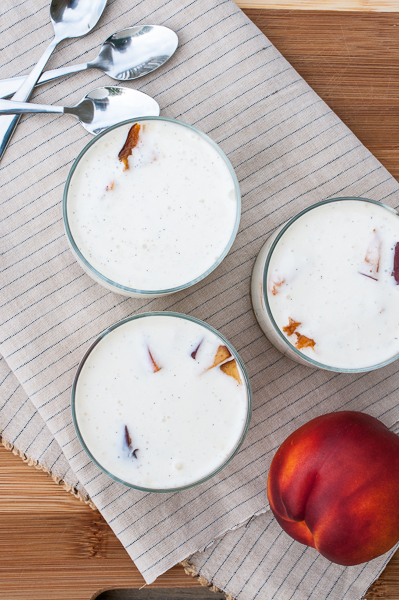In high school, I had the privilege of traveling to France (and Monaco) for 17 days with my French class. I did not so much enjoy high school, but I really, really loved that trip! We started in Paris & then traveled via motor-coach in a giant circle around the rest of the country.
For most of the trip, we ate lunch on our own in whatever city we happened to be visiting that day. Even in high school, I knew that someday I wanted to study pastry. I am not at all ashamed to say that most every lunch included dessert. Sometimes, dessert was the only food group! Luckily, the friends I made during the trip agreed with dessert for lunch :)
One day, towards the tail end of the trip when we were in the norther part of France, along the cost, I bought a “Mille-Feuille” (also known as a “Napoleon”) for lunch. It was a beautiful pastry, layered with cream & strawberries, and topped with a healthy dusting of confectioners‘ sugar. Somewhere in my boxes of France mementos at my parents’ house is a photo I took of the pastry...
While the napoleon may have looked exquisite & delicious, it only took one bite for me to realize that the pastry was burned. Badly burnt. Sadly, I ended up throwing out the pastry layers and just eating the cream & strawberries. Even though this first napoleon experience was not-so-great, I knew that someday I would eat a better one.
That trip to France did really help further my palate, & it exposed me to new things within the culinary world . Pistachio, in particular, remains one of my all time favorite flavors. As does red currant. And, of course, I fell in love with croissants, pain au chocolat, jam & nutella for breakfast.
Fast forward just a few years (ha!) to my time in culinary school. Laminated Doughs & Breakfast Pastries quickly became my favorite class. We made our own puff pastry, laminated it with European butter, and one week we turned some of the finished puff pastry into amazingly delicious, yet challenging Napoleons. Finally, I tasted a real napoleon that wasn’t burned!

Classical napoleons, topped with poured fondant & chocolate stripes, aren’t an easy task. They require lots of work & also require the person making/assembling them to be on top of their “mis-en-place,” meaning that everything must be completely ready & in place before the assembly process begins. I struggled with the napoleon as a student & while my pastry was delicious, it wasn’t nearly as beautiful as it should have been (or as beautiful as Chef Jeff’s was). When I became an instructor & taught the Laminated Doughs class, I still was a little nervous on napoleon day when I had to demo this challenging item to 16 eager students (and then grade them on their results)....

While I love the classical napoleon, both for it’s flavor and for the skill it requires one to possess to execute flawlessly, I experimented with alternate presentations for the same components. The squares were pre-cut to their serving size. The vanilla diplomat cream filling was decoratively piped. Fruit could be added. The fondant & chocolate topping was exchanged for a pattern of powdered sugar.
I have a terrible habit of hoarding ingredients I deem “special.” As I was brainstorming future posts & looking through my cabinets & freezer, I remembered the remaining piece of
gluten free blitz puff pastry that needed to be used before it developed freezer burn. And in the dark, back corner of the pantry, I discovered an even bigger gem: pistachio paste! Ironically, I brought the pistachio paste back from my
second trip to France . I’ve been saving it for a special occasion, but really, that just means it’s just hiding in my pantry. My aformentioned love of pistachio drove me to buy the paste three years ago, but allowing it to just sit in the back of the pantry really does no one any favors. So, I cracked the can open, inhaling the wonderful fragrance of pistachios & was inspired to make a pistachio napoleon with raspberries. Not only are pistachios and raspberries visually pretty together, their flavors also are a great compliment.
I knew there wasn’t enough leftover blitz puff pastry to make very many napoleons, so in lieu of just eating the pistachio diplomat cream with a spoon (which it IS delicious enough to do), I bought a box of commercial puff pastry. I used the regular puff pastry to make a couple napoleons to give as thank-you gifts.
In one bite of the napoleon, I’m transported both back to my trips to France, and also to my days as a culinary student & instructor. Good memories :)
PISTACHIO RASPBERRY NAPOLEONS - In the above images, the larger napoleon was made with commercial, store-bought puff pastry. The smaller, individual size napoleon was made with gluten free blitz puff pastry.
- The batch of pastry cream & diplomat cream will make enough to fill two sheets of regular puff pastry and all the gluten free pastry rectangles as well.
Baking Commercial Puff Pastry Sheets (large Napoleons) - Allow the puff pastry to thaw at room temperature for approximately an hour. Preheat the oven to 400 F.
- Open the package & separate the two pieces of puff pastry. Save the second piece for later (or hold it in the refrigerator until the first pieces is done & then repeat the steps.) Gently open the folds of the pastry.
- Using a pastry wheel & a ruler (I like to use my quilter’s ruler), cut off the edges of the puff pastry pieces, just to expose the lamination. Cut each piece into three equal pieces approximately 3 inches wide.
- Place the 3” wide pieces onto a parchment-lined baking sheet. Use a fork to dock the dough (make little holes in it) all over the surface of the dough. Top with a second piece of parchment & a second sheet pan. The puff pastry should now be sandwiched between the parchment & the pans. Add a heavy, oven-safe weight to the top pan--I like to use my cast iron skillet.
- Bake the skillet-topped pans for 30 minutes. Remove from the oven & remove the cast iron skillet (DON’T FORGET THAT THE PANS ARE HOT!!) Flip the pans with the pastry over & remove the top pan (which was previously the bottom) and the top layer of parchment. Return the pan to the oven (the bottom pan will be upside down, but that’s OK). and continue baking until the pastry is golden. Rotate as needed to promote even browning. The finished pastry should be quite brown, but not burned. Mine took approximately 7 additional minutes to bake. Allow the baked pastry to cool at room temperature.
- After the rectangles have trim with a small, sharp paring knife until all the pieces are the same size & the edges have been re-exposed. Save any scrap pieces to eat with leftover diplomat cream :) Some of the rectangles may break, but just use those for the bottom or inside layers when assembling. Decide which piece is the prettiest & reserve that one for the top. Set aside until ready to assemble.
Baking Gluten Free Blitz Puff Pastry (individual Napoleons)- Allow the frozen blitz puff pastry to thaw at room temperature for approximately 10 minutes (for a flat sheet)
- Use a ruler & pastry wheel to cut the dough into 2x4 inch rectangles.
- Place the rectangles onto a parchment lined baking sheet. Return to the freezer for 10 minutes.
- Preheat the oven to 400 F.
- Bake the rectangles for 25 minutes (or until lightly golden). Remove the pan from the oven. With an offset spatula, very carefully flip each piece over. They do tend to ooze a bit of butter & that hot butter will burn!
- Return the pan to the oven and bake for 5 to 10 more minutes, or until the pastry is golden.
- Remove from the oven & cool to room temperature.
Pastry CreamNote: Cut the batch in half if you aren’t planning on assembling more than 1 napoleon (i.e. using more than 1 sheet of commercial puff pastry). I bought my pistachio paste in France, but you can find several kinds here. Alternately, unsalted pistachios can be steeped in milk & then pureed, but the flavor will not be as strong & the texture will be much more grainy.
9.75 oz Milk1.5 oz Pistachio Paste1 fl oz cold Water0.15 oz Granulated Gelatin (approximately half a packet)2 oz Egg Yolks (approximately 4 yolks, don’t worry if it goes a little over)4 oz Granulated Sugar0.85 oz Cornstarch0.55 oz Butter- In a medium sized stainless steel sauce pan, combine the milk and pistachio paste. Heat over medium heat until it simmers, whisking often. Remove from the heat, cover & allow to steep 10 minutes or so while the other ingredients are prepared.
- In a microwave safe small bowl, add the cold water. Sprinkle the gelatin over the cold water. Stir lightly to ensure all the granules are moistened. Set aside to bloom.
- Separate the cold eggs. Reserve the whites for a different use.
- In a medium sized heat-proof bowl (glass, metal, etc.), Whisk together the granulated sugar & cornstarch.
- Return the pistachio milk to the stove top & heat over medium high heat until it begins to steam. Meanwhile, whisk the egg yolks into the granulated sugar/cornstarch mixture. Place a damp towel or a silicone pot holder underneath the bowl if it moves around too much. Do not allow this mixture to sit or the sugar may cause the egg mixture to chemically cook & create lumps in the final cream.
- Slowly temper the hot pistachio liquid into the egg mixture, while whisking constantly. Once all the two are combined, return them to the sauce pan and heat over medium high heat, whisking constantly.
- Continue cooking & mixing until the custard boils. Allow to boil for a minimum of 15 seconds (count slowly), then remove from the heat. Whisk in the butter
- Place the bloomed gelatin into the microwave & heat on high for 10 seconds (or until liquid). Whisk the melted gelatin into the custard. Pour the custard into a separate bowl & cover with plastic wrap touching the surface. Refrigerate until ready to make the diplomat cream, just before assembly.
Diplomat Cream Wait to make the diplomat cream until just before assembly! It won’t pipe as well if made earlier. Cut the batch in half if you aren’t planning on assembling more than 1 napoleon (i.e. using more than 1 sheet of commercial puff pastry)16 oz Pastry Cream (with the gelatin added) 16 oz Whipping Cream1 tsp Vanilla Bean Paste (or substitute extract) - Approximately 30 minutes before making the diplomat cream, remove the pastry cream from the refrigerator & allow to come to room temperature.
- In the bowl of a stand mixer fitted with the whisk attachment, whip the cream until medium peaks form. Beat in the vanilla bean paste.
- Whisk the room temperature pastry cream to break it up a bit. Add half of the whipped cream to the pastry cream & whisk to combine. Pour the pastry cream/whipped cream back into the bowl of whipped cream & gently fold to combine.
- Refrigerate for 10 minutes.
- Fill a pastry bag fitted with a large round tip (I used an Ateco #808). Reserve any leftovers in the refrigerator in an airtight container for up to 3 days.
Tri-layer AssemblyBaked Puff pastry pieces, trimmed (regular, not gluten free ones)Diplomat Cream1/2 to 1 pint Raspberries, unwashed Confectioners sugar Pistachios, finely chopped (optional garnish) - Build the napoleon on a parchment lined sheet pan. Pick through the raspberries & decide which ones are prettiest for the outside edges and which ones are not as beautiful that may be hidden on the inside. Set aside a couple of extra pretty garnish berries, if desired. Lay out the raspberries on some paper towel. Do NOT wash them. Due to their fragile nature, the raspberries may not hold up as well if they are washed & they risk bleeding into the pastry cream.
- On the base layer, pipe three large dots/rounds with the diplomat cream along the short side of the baked puff pastry. Next to the dots, snuggly place 4 raspberries (or however many fit best), remembering to put the prettiest ones towards the outside where they will be seen. Repeat the cream dots & raspberry rows throughout the remaining width of the pastry. Top with a second piece of puff pastry & gently press to adhere, but not so hard that the cream and berries are squashed.
- Repeat the cream and berry layer process on the second tier of pastry. Top with the prettiest piece of pastry. Lightly press.
- Place the pan into the refrigerator to chill the napoleon for at least 1 hour and up to 4 hours.
- Just before serving, cut parchment paper into equal strips. Lay the strips diagonally across the top of the pastry. Liberally sift powdered sugar over the top. Gently remove the strips, being careful not to disrupt the sugar pattern. On one corner, lay an extra line of chopped pistachios. Top with a couple additional fresh raspberries.
- Serve immediately. Use a hot, but dry, serrated knife to cut the napoleon into pieces. Because pastry will begin to get soggy, this dessert is best consumed within 24 hours of assembly. Store any leftovers in an airtight container (or well wrapped) in the refrigerator. Leftovers will become soggy, but will still still taste delicious.
Individual variation (Gluten Free)
- Follow the same steps as before, only make the individual napoleons two layers instead of three.


























































